History is filled with incidents that are so odd, they strain believability. Take John Adams and Thomas Jefferson dying on the very same day. (July 4, 1826 – which happened to be the 50th anniversary of the signing of the Declaration of Independence, which also carried both men’s signature. How do you explain that? I can’t.)
For sheer weirdness, though, nothing compares to the time when France and Mexico fought the Pastry War, Santa Anna lost a leg, and we (the U.S.) wound up with it. Don’t worry – I can explain everything. So sit back and enjoy the strangest tale you’ll ever hear.
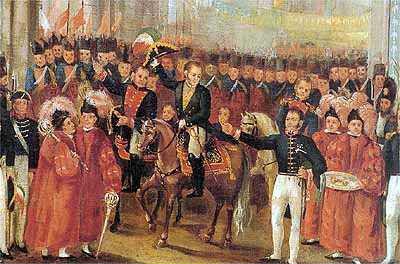 It all started in the 1820s, when Mexico broke free from Spain. There was much unrest and violence in the new nation’s first decade. The worst came in 1828, when Mexico City was rocked by four days of rioting, looting and killing. Among the damaged businesses ransacked by drunken Mexican soldiers was a pastry shop owned by (who else?) a Frenchman named Remontel. He tallied his loss at 10,000 pesos (by comparison, an unskilled laborer earned one peso a day at that time), and he asked Mexico’s government to reimburse him. They said no.
It all started in the 1820s, when Mexico broke free from Spain. There was much unrest and violence in the new nation’s first decade. The worst came in 1828, when Mexico City was rocked by four days of rioting, looting and killing. Among the damaged businesses ransacked by drunken Mexican soldiers was a pastry shop owned by (who else?) a Frenchman named Remontel. He tallied his loss at 10,000 pesos (by comparison, an unskilled laborer earned one peso a day at that time), and he asked Mexico’s government to reimburse him. They said no.
After years of getting the runaround, Monsieur Remontel moved back to Paris. He kept trying to recover his lost money, ultimately appealing to King Louis-Philippe himself, who was eager to assist because Le Roi had a bone to pick with the Mexicans.
 Which is where Antonio de Padua María Severino López de Santa Anna y Pérez de Lebrón enters our story. Yes, THAT Santa Anna, the original Bad Boy of American history. He was an arrogant jerk who served as Mexico’s president for multiple non-consecutive terms over 22 years. He kept making it through the revolving door to the president’s office, only to tick off people and be tossed out on his rump, then weasel his way back in.
Which is where Antonio de Padua María Severino López de Santa Anna y Pérez de Lebrón enters our story. Yes, THAT Santa Anna, the original Bad Boy of American history. He was an arrogant jerk who served as Mexico’s president for multiple non-consecutive terms over 22 years. He kept making it through the revolving door to the president’s office, only to tick off people and be tossed out on his rump, then weasel his way back in.
He infuriated thousands of American immigrants to the point where in 1836 they declared the independent Republic of Texas. Mexico’s finances were a perpetual basket case in those days, and it borrowed millions from France to fight the Texans. Remember the Alamo? The Goliad Massacre? Santa Anna was responsible for those and other war crimes. And after eventually being defeated and captured at the Battle of San Jacinto, Santa Anna was out of a job. It seems losing a big chunk of your country’s territory doesn’t look good on a presidential resume.
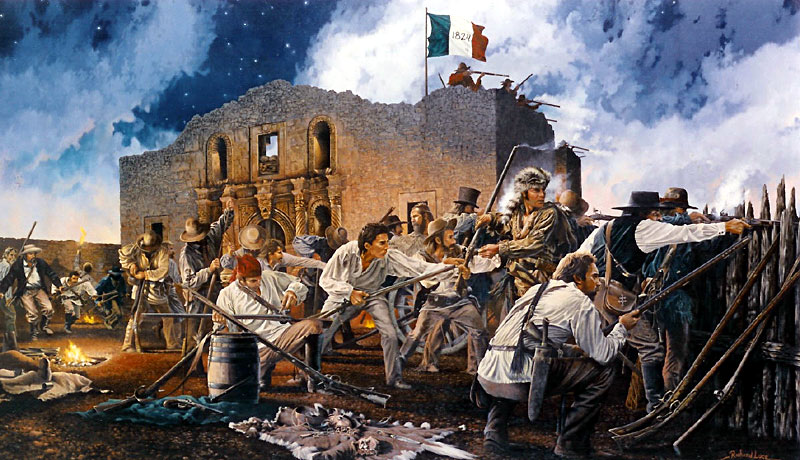 By 1838, Mexico hadn’t repaid one centavo of its war debt and France’s Louis-Philippe was out of patience. Monsieur Remontel’s petition pushed him over the edge. He demanded the Mexicans immediately pay France a staggering 600,000 pesos (60,000 for the pastry shop –six times the loss– with the rest going toward the outstanding loan balance). The Mexicans blew it off.
By 1838, Mexico hadn’t repaid one centavo of its war debt and France’s Louis-Philippe was out of patience. Monsieur Remontel’s petition pushed him over the edge. He demanded the Mexicans immediately pay France a staggering 600,000 pesos (60,000 for the pastry shop –six times the loss– with the rest going toward the outstanding loan balance). The Mexicans blew it off.
But no one was laughing when a massive French naval fleet showed up off the Gulf coast that December, capturing Mexico’s entire navy and blockading the important port city of Veracruz, the country’s lifeline to international trade. Mexico responded by declaring war.
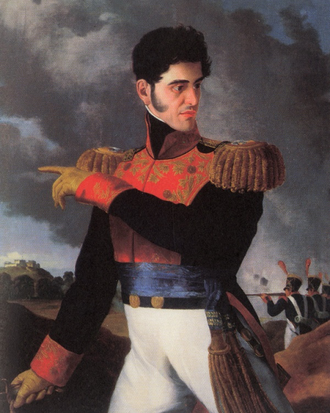 Veracruz just happened to be Santa Anna’s hometown. Without any authorization (or even being asked) he made a dramatic inspection of the city’s defenses, then offered his services to Mexico’s president du jour who, figuring beggars couldn’t be choosers, put Santa Anna back in command of the army. Early in 1839, Santa Anna was wounded by cannon fire and his leg was amputated. (More in a minute on how he milked that for all it was worth.)
Veracruz just happened to be Santa Anna’s hometown. Without any authorization (or even being asked) he made a dramatic inspection of the city’s defenses, then offered his services to Mexico’s president du jour who, figuring beggars couldn’t be choosers, put Santa Anna back in command of the army. Early in 1839, Santa Anna was wounded by cannon fire and his leg was amputated. (More in a minute on how he milked that for all it was worth.)
Mexico’s leaders negotiated a peace deal, quickly agreeing to pay France the 600,000 pesos. And so three months, one week and three days after it started, the Pastry War officially ended on March 9, 1839, with 68 French and 224 Mexican casualties.
The French were thrilled to find someone they could beat (for a change). But the big winner in this farce was Santa Anna. He paraded his lost leg through Mexico City’s streets with great pomp and buried it in an elaborate ceremony complete with flowers, poems, cannon salutes, speeches and a huge stone monument. It was a major public relations coup. Thanks to the widely promoted loss of his limb, Mexicans forgave Santa Anna for the loss of Texas.
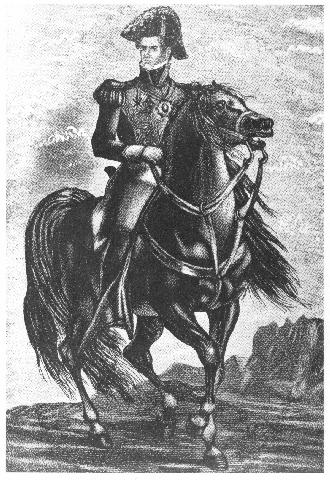 With his popularity restored, he was perfectly positioned when the “help wanted” sign inevitably reappeared at the president’s office, and he got his old job back.
With his popularity restored, he was perfectly positioned when the “help wanted” sign inevitably reappeared at the president’s office, and he got his old job back.
It was yet another disastrous term. Santa Anna ruled liked a tyrant this time. He also tried to fill Mexico’s City empty coffers by raising taxes. And you know how that always goes over.
Little surprise then that public opinion swiftly turned against him – and his amputated leg. In 1844, protesters tore down the monument, dug up the leg, tied a rope around it and dragged it through Mexico City’s streets shouting, “Death to the cripple!” (No word on what happened to the leg; for all I know, a dog may have made off with it.) Santa Anna was hustled off to exile in Cuba.
While all this was going on, the on-again/off-again president and general was hobbling around on an artificial leg. And not just any old prosthetic, either. It was state of the art for the 1840s, featuring ball bearings, canvas strap thigh buckles and a real leather boot, too, custom made in New York City for $1,300 (about $35,000 in today’s dollars). He also had a spare backup, a traditional peg leg made of cork.
When the United States declared war on Mexico in 1846, Santa Anna was itching to get back in the action. He wrote to Mexico’s president, saying he had no desire to seek the presidency again; he just wanted to lead Mexican troops in battle one more time. He also secretly told the Americans that if they allowed him to slip through the U.S. blockade and return to Mexico, he would sell a huge chunk of Mexican territory to Washington at a bargain price. Both agreed to his proposals, and both soon regretted it, for Santa Anna reneged on each offer.
Back on Mexican soil, he seized the presidency once more, and went on to be soundly trounced on the battlefield.
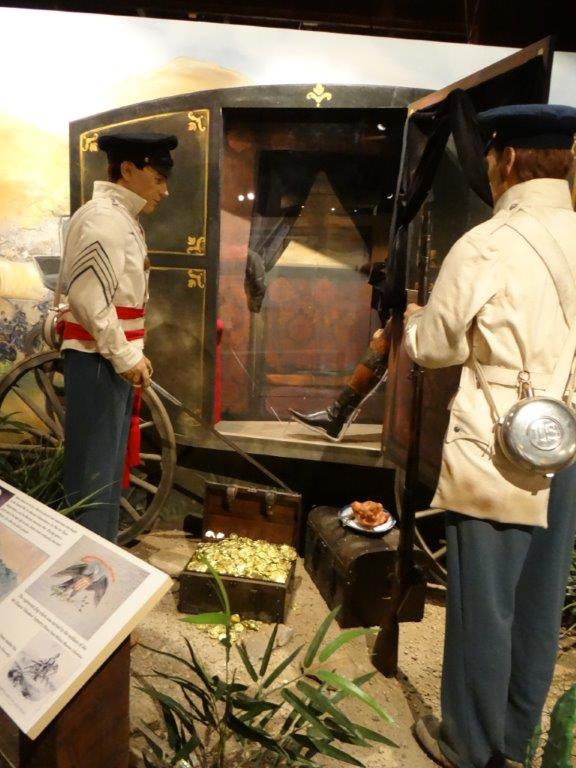 Something interesting happened at the Battle of Cerro Gordo. The Fourth Illinois Infantry caught Santa Anna by surprise. He fled for his life, leaving behind his carriage containing a warm chicken dinner (which the Americans ate), a chest holding $18,000 in gold (which they turned over to General Winfield Scott) and both the fancy and plain artificial legs (which they kept as war trophies).
Something interesting happened at the Battle of Cerro Gordo. The Fourth Illinois Infantry caught Santa Anna by surprise. He fled for his life, leaving behind his carriage containing a warm chicken dinner (which the Americans ate), a chest holding $18,000 in gold (which they turned over to General Winfield Scott) and both the fancy and plain artificial legs (which they kept as war trophies).
Santa Anna surrendered (again) and went into exile (again). Incredibly, even after all that had happened, Mexican political insiders still hadn’t learned their lesson, and they invited him to return for a Last Hurrah as president in the 1853. Santa Anna hadn’t learned anything, either, because he stole liberally from the government and proclaimed himself dictator-for-life with the title “Most Serene Highness.”
Santa Anna Fatigue finally set in, and he was driven from office for the final time in 1854.
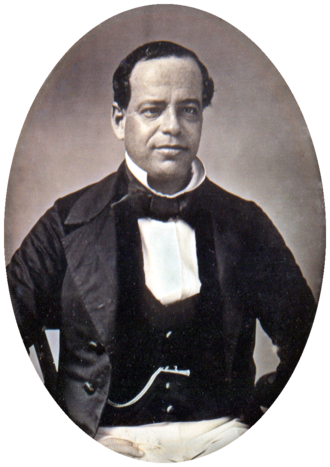 The deposed ex-El Presidente bounced around for a few years before finally settling in Staten Island, New York – of all places. Yes, Santa Anna, the same man who killed Davy Crockett and all the others at the Alamo, lived in America from 1866 to 1874, where he ran a scheme to import chicle from Mexico. In case you were absent the day it was discussed in science class, chicle is a natural gum harvested from sapodilla trees. The plan was to use it as a cheap substitute for rubber (and use the profits to finance yet another glorious return to power). Nobody bought it, and the operation went belly up.
The deposed ex-El Presidente bounced around for a few years before finally settling in Staten Island, New York – of all places. Yes, Santa Anna, the same man who killed Davy Crockett and all the others at the Alamo, lived in America from 1866 to 1874, where he ran a scheme to import chicle from Mexico. In case you were absent the day it was discussed in science class, chicle is a natural gum harvested from sapodilla trees. The plan was to use it as a cheap substitute for rubber (and use the profits to finance yet another glorious return to power). Nobody bought it, and the operation went belly up.
 But it wasn’t a total loss; after parting ways, Santa Anna’s American business partner kept tinkering with chicle. He sweetened and flavored it to create “rubber chewing gum.” (Ever heard of Chiclets?) That guy made millions; Santa Anna didn’t get a dime.
But it wasn’t a total loss; after parting ways, Santa Anna’s American business partner kept tinkering with chicle. He sweetened and flavored it to create “rubber chewing gum.” (Ever heard of Chiclets?) That guy made millions; Santa Anna didn’t get a dime.
Finally, the former “Most Serene Highness” was allowed to move back to Mexico under an amnesty decree in 1874. He died two years later at age 84, nearly blind and broke.
But while the man was gone, his strange tale lived on through his artificial legs.
Both were carried back to Illinois. The plain one somehow wound up in the home of Union general and three-term Governor Richard Oglesby in Decatur, where it must have been quite a conversation piece. (“Wait till you see what we’ve got in the drawing room!”)
A Mexican War veteran toured the fancy one around the state for years, charging 10 cents a peek at county fairs. The Illinois State Military Museum has had it since 1922, where for decades it was a quiet, rusty relic.
 Then in 1998, the cartoon series King of the Hill ran an episode about a (fictitious) plot to kidnap Santa Anna’s leg. That revived interest in the artifact; so much so that in 2006 the museum made it the centerpiece of a display showcasing its capture, complete with carriage, box of gold and chicken dinner.
Then in 1998, the cartoon series King of the Hill ran an episode about a (fictitious) plot to kidnap Santa Anna’s leg. That revived interest in the artifact; so much so that in 2006 the museum made it the centerpiece of a display showcasing its capture, complete with carriage, box of gold and chicken dinner.
Over the years, Mexico’s government has repeatedly asked Washington to return the leg south of the border. Each time the request was denied.
Just last year, the folks at the San Jacinto Museum of History jumped into the fray. They launched a petition on the White House website, trying to get 100,000 signatures to bring the leg to Texas. They say it’s a more fitting place, since Santa Anna surrendered there (the first time around), rather than Illinois, where there’s no record of Santa Anna ever visiting.
 The folks in the Land of Lincoln just smile, and politely remind the Texans that possession is nine tenths of the law.
The folks in the Land of Lincoln just smile, and politely remind the Texans that possession is nine tenths of the law.
So while the struggle over who will have custody of Santa Anna’s lost limb in the 21st Century drags on, the brief, bizarre 19th Century conflict that set it in motion, the Pastry War, lies forgotten at the bottom of the great Toy Box of History, waiting for someone to rummage around and discover it.
Did you find this enjoyable or helpful? Please continue to join me each week, and I invite you to read Tell it Like Tupper and share your review!
Curious about Tell It Like Tupper? Here’s a chance to see for yourself. Take a sneak peek at a couple chapters in this free downloadable excerpt.

Pingback: Bag of Randomness for Friday, April 7, 2017 | BagOfNothing.com